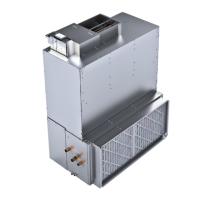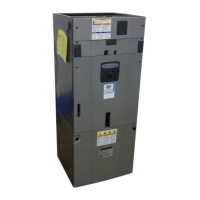126
BCX-SVX002A-EN
Table 44. Diagnostics on the receiver
LED state Indicates...
LED1: Off
LED2: Off
LED3: 1-blink pattern repeated
continuously
(a)
Disassociated
Receiver is not associated, waiting for a sensor.
Receiver lost communication with sensor.
Receiver has no devices on its wireless personal area network.
Association with a device has been manually removed.
LED1: Off
LED2: Off
LED3: 2-blink pattern repeated
continuously
(a)
Address set to 000
Address not set to between 001–999.
LED1: Off
LED2: Off
LED3: 3-blink pattern repeated
continuously
(a)
Not configured
Receiver configuration properties not properly set (defective receiver).
(a)
Blink pattern is On for 1/4 s, Off for 1/4 s, with 2 s Off between repetitions.
Sensor Diagnostics
LED1, LED2, and LED3, located on the WZS respond to
diagnostics by exhibiting specific blinking patterns. View
their response by pressing the Test button.
Error codes appear on the WDS when diagnostics occur
(see the following table).
Table 45. Diagnostics for wireless zone sensors and error code shown on wireless display sensor
LED state when Test button is pressed on
WZS
Error code shown on WDS Indicates...
n/a E0, E5, E7 Sensor failure
Replace sensor
LED1: Off
LED2: Off
LED3
(a)
: 1-blink pattern repeated 3 times
E1 Disassociated
Sensor is not associated with a receiver.
LED1: Off
LED2: Off
LED3
(a)
: 2-blink pattern repeated 3 times
E2 Address set to 000
Address not set to between 001–999.
LED1: Off
LED2: Off
LED3
(a)
: 3-blink pattern repeated 3 times
E3 Software error
Replace sensor
LED1: Off
LED2: Off
LED3
(a)
: 4-blink pattern repeated 3 times
E4 Input voltage too high
No RF transmission is permitted with an input battery voltage
greater than 3.9 V.
(a)
Blink pattern is On for 1/4 s, Off for 1/4 s, with 2 s Off between repetitions.
Testing Signal Strength
To initiate a signal strength test, push the Test button on the
sensor (see location of Test button in Figure 103, p. 125
and Figure 104, p. 125.
Models WZS: LED1, LED2, and LED3 respond by
indicating signal strength. You can view them on the sensor
(Table 46, p. 127) and the receiver (Table 47, p. 127).
Model WDS: Test symbols on the sensor display indicate
signal strength (Table 46, p. 127). LED1, LED2, and LED3,
on the receiver, respond by indicating signal strength
(Table 47, p. 127).
Diagnostics and Troubleshooting

